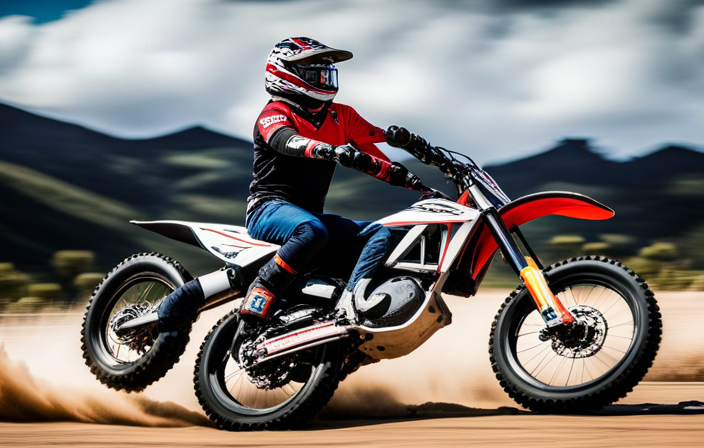Get ready to unlock the potential of your electric bike with this step-by-step guide on how to remove the freewheel.
Just like a hidden treasure waiting to be discovered, the freewheel holds the key to enhancing your cycling experience.
Armed with the right tools and a little know-how, you’ll be able to free your bike from the constraints of its current freewheel and unlock new possibilities.
So, let’s dive in and embark on this journey of bike transformation together.
Key Takeaways
- Gather all the necessary tools and ensure they are in good condition before starting the freewheel removal process.
- Use an adjustable wrench to loosen the axle nut counterclockwise and remove it by hand.
- Carefully remove the washers positioned on both sides of the axle and keep track of their order.
- Choose either a wrench or a chain whip to loosen the freewheel, applying counterclockwise force to remove it from the hub.
Gather the Necessary Tools
Gather all the necessary tools before starting to remove the electric bike freewheel. When it comes to electric bike maintenance, troubleshooting electric bike issues can be a common task. To successfully remove the freewheel, you will need a few specific tools.
Start by grabbing a freewheel removal tool that matches the type of freewheel on your electric bike. You’ll also need an adjustable wrench, a chain whip, and a large vice grip. These tools will ensure that you can easily remove the freewheel without causing any damage to your electric bike.
Once you have all the tools ready, you can proceed to prepare your electric bike for freewheel removal. This will involve securing the bike in place and ensuring that it is stable throughout the process.
Prepare Your Electric Bike
First, make sure you’re fully prepared for the task ahead on your e-bike. Electric bike maintenance is crucial to ensure the smooth operation of your ride.
Before attempting to remove the freewheel, it’s important to troubleshoot common issues that may arise. Check for any unusual sounds or grinding sensations while pedaling, as this could indicate a problem with the freewheel. Additionally, inspect the chain and gears for any signs of wear or damage. By addressing these issues beforehand, you can avoid complications during the removal process.
Now that you have assessed the condition of your electric bike, it’s time to move on to the next step: removing the axle nut and washers. This will allow you to access the freewheel and proceed with its removal.
Remove the Axle Nut and Washers
Next, unscrew the axle nut and remove the washers to gain access to the freewheel. To do this, you’ll need a few tools such as an adjustable wrench and a pair of pliers.
Start by using the adjustable wrench to loosen the axle nut in a counterclockwise direction. Once the nut is loose, you can easily remove it by hand.
After removing the nut, carefully take off the washers that are positioned on both sides of the axle. These washers help to secure the freewheel in place. It’s important to keep track of the order in which the washers are removed, as they may need to be placed back in the same order during reassembly.
With the axle nut and washers removed, you now have access to the freewheel and can proceed to the next step of attaching the freewheel removal tool.
Attach the Freewheel Removal Tool
To attach the freewheel removal tool, you’ll need to firmly insert it into the freewheel and ensure it is securely in place. Here are a few tips to help you with this step:
- Make sure the removal tool matches the size and type of your freewheel.
- Align the splines on the removal tool with those inside the freewheel, ensuring a snug fit.
- Hold the removal tool with one hand and use the other hand to tighten it by turning it clockwise.
- Ensure the removal tool is fully engaged with the freewheel, as any looseness can cause damage during removal.
- Double-check the tool’s position and tightness before proceeding.
By following these steps, you’ll be ready to move on to the next section where we’ll discuss how to use a wrench or chain whip to loosen the freewheel. This is an essential part of electric bike maintenance.
Use a Wrench or Chain Whip to Loosen the Freewheel
You can use either a wrench or a chain whip to loosen the freewheel. A wrench is a versatile tool that can be used for a variety of tasks, including loosening the freewheel. To use a wrench, you will need to find the appropriate size that fits the freewheel’s lockring. Once you have the right size wrench, position it on the lockring and apply force in a counterclockwise direction to loosen it. On the other hand, a chain whip is a specialized tool designed specifically for removing freewheels. It consists of a metal chain and a handle. To use a chain whip, you will need to wrap the chain around the freewheel, ensuring that it engages with the teeth. Then, hold the handle firmly and apply force in a counterclockwise direction to loosen the freewheel. Alternatively, if you don’t have a wrench or a chain whip, you can use other tools like a breaker bar or a vice grip to achieve the same result. After loosening the freewheel, you can proceed to unscrew it from the hub in the next section.
Unscrew the Freewheel from the Hub
Once the freewheel is loosened, it can be unscrewed from the hub. To remove the freewheel, follow these steps:
- Use a freewheel removal tool that matches your specific freewheel type.
- Insert the removal tool into the freewheel and ensure it is securely in place.
- Attach a wrench or socket to the removal tool and rotate counterclockwise to unscrew the freewheel.
- Apply steady pressure while turning to avoid stripping the threads.
- Once the freewheel is completely unscrewed, carefully remove it from the hub.
Removing the freewheel is an essential skill in electric bike maintenance, especially when troubleshooting electric bike issues. By understanding how to remove the freewheel, you can gain access to the hub, allowing you to clean and inspect it thoroughly.
This step is crucial in ensuring the optimal performance and longevity of your electric bike.
Clean and Inspect the Hub
After successfully unscrewing the freewheel from the hub, it is important to thoroughly clean and inspect the hub before proceeding any further.
Proper inspection of the hub is crucial for identifying any potential issues or damage that may affect the performance of the electric bike. Start by cleaning the hub using a mild degreaser and a brush to remove any dirt or grime. Pay close attention to the bearings and ensure they are clean and in good condition.
Inspect the hub for any signs of wear, cracks, or damage, as these could indicate the need for replacement parts. Additionally, check the axle for any bent or damaged sections.
Once the hub is clean and inspected, you can proceed to install a new freewheel (optional) by following the next section.
Install a New Freewheel (optional)
To install a new freewheel, start by cleaning and inspecting the hub to ensure it is in good condition. This step is crucial to guarantee a smooth and efficient installation process.
First, remove the old freewheel using a freewheel removal tool and carefully clean the hub using a brush and degreaser. Inspect the hub for any signs of wear or damage, such as worn teeth or bent threads.
If the hub is in good condition, you can proceed with installing the new freewheel. Choose a freewheel that suits your needs, whether you’re installing accessories or upgrading the drivetrain.
Align the splines of the freewheel with those on the hub and tighten it securely using a freewheel installation tool.
With the new freewheel in place, you can now move on to reassembling your electric bike, ensuring all components are properly tightened and secured before your next ride.
Reassemble Your Electric Bike
Now you can start putting your electric bike back together. Here are some reassembly tips to ensure a smooth process:
-
Begin by reattaching the rear wheel to the frame. Make sure it’s securely fastened and aligned properly.
-
Connect the brake cables and make sure they’re properly tensioned. Test the brakes to ensure they’re functioning correctly.
-
Reattach the chain to the freewheel and make sure it’s properly lubricated.
Troubleshooting common issues during reassembly:
- If the chain isn’t shifting smoothly, check the derailleur alignment and adjust if necessary.
- If the brakes aren’t working properly, check for any loose connections or adjust the cable tension.
Once you’ve finished reassembling your electric bike, you can now test it and enjoy the ride.
Test Your Bike and Enjoy the Ride
Hop on your newly reassembled e-bike and have a blast riding it!
Before embarking on your test ride, it’s important to ensure that your bike is in optimal working condition. Start by checking the tire pressure and adjust it accordingly.
Inspect the brakes to ensure they are functioning properly and adjust them if necessary.
Test the gears to ensure smooth shifting and adjust the derailleur if needed.
Take a moment to check the battery level and make sure it is fully charged.
Once on the road, pay attention to any unusual noises or vibrations that may indicate a problem.
During your ride, make note of any adjustments or maintenance tasks that may be required, such as tightening loose bolts or cleaning the chain.
Remember, regular maintenance is key to keeping your e-bike running smoothly and efficiently.
Enjoy your ride and stay safe!
Frequently Asked Questions
How long does it typically take to remove an electric bike freewheel?
It typically takes me around 15-30 minutes to remove an electric bike freewheel. To properly reinstall it, I recommend following the manufacturer’s instructions and ensuring all components are securely tightened.
Can I remove the freewheel without using a freewheel removal tool?
Yes, it is possible to remove the freewheel without a removal tool. However, it is not recommended as it can be difficult and may cause damage to the freewheel or the bike.
Is it necessary to clean and inspect the hub after removing the freewheel?
Yes, it is necessary to clean and inspect the hub after removing the freewheel. Before removing the freewheel, it is important to clean the hub thoroughly and inspect it for any damage or wear that may require further maintenance or replacement.
What should I do if the freewheel is stuck and cannot be unscrewed from the hub?
If the freewheel is stuck, I recommend trying alternative methods such as using penetrating oil or heat to loosen it. If all else fails, seek professional assistance to avoid damaging the hub.
Are there any specific safety precautions I should take before attempting to remove the freewheel?
Before attempting to remove the freewheel, safety precautions are vital. Begin by wearing protective gloves and goggles. Ensure the bike is stable and secure. Gather the necessary tools and familiarize yourself with the freewheel removal process.
Conclusion
In conclusion, removing the freewheel from your electric bike is a relatively straightforward process that can be done with the right tools and a bit of patience. By following the steps outlined in this article, you can successfully remove and replace the freewheel, ensuring a smooth and enjoyable ride.
Did you know that electric bikes are becoming increasingly popular? In fact, sales of electric bikes have grown by 145% since 2019, showing that more and more people are embracing this eco-friendly and efficient mode of transportation.









